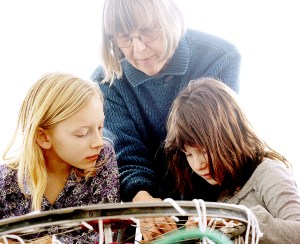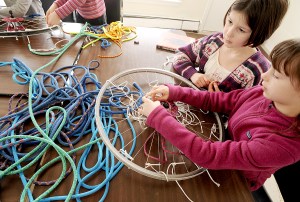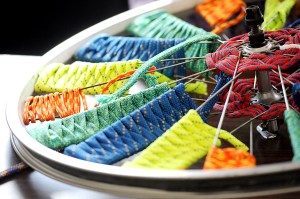FREEPORT — Ann Thompson figures if she starts the kids on weaving with bicycle wheels, they’ll take it from there.
“They learn about spiders or what makes up nylon, or the history of World War II,” Thompson said. “Whatever. It’s a nice connector, a conduit to a lot of things and it teaches kids that they can build on an idea.”
It’s what Thompson, 63, of Biddeford, is doing over the next several Thursdays to students at the Homeschool Resource Center in Freeport. She brings in the materials — bicycle wheels and stems donated from Community Bike Center and the Sterling Rope, both in Biddeford — and teaches the kids the method.
They cut the donated nylon climbing rope into usable lengths and pull out the white centers leaving the colorful outsides. Those are flattened against the sides of a table or chair and wrapped around the spokes of the donated bike wheels to form patterns, whirls of color and propeller blades.
Residents of Freeport can enjoy the results throughout the spring. The kinetic sculptures created by the students will be on display in front of the Freeport Public Library once they’re finished.
“We create an aerodynamic pattern that catches the wind and creates moving patterns,” she said.
Weaving the pattern is a big part of it, she said, but there’s more the kids can learn. They’ve talked about nylon in the ropes and how it’s made. They’ve talked about spiders and the silk they use to weave their webs and how nylon came to be used during World War II.
“We’re also teaching them about recycling and creative reuse and about how things can be used for purposes different from what they were first made for,” Thompson said.
A big buzzword in educational circles right now is STEM — Science, Technology, Engineering and Math. The idea is to reignite interest in the technical studies that future industries are built on.
Thompson said what she does adds art to the mix. She calls it “STEAM.”
“So much of art education in recent years has become much more academic,” she said. “They have to meet learning results, so they do art history and criticism but not so much hands-on. They do some, but it’s much harder to do.”
And kids need opportunities to do hands-on work, especially today, she said.
“Most kids today spend a lot of time looking at screens. When they do build, the building they do is Legos and K’Nex and those kits. They’re great, but that’s not the way things are put together in the real world. Things don’t always snap perfectly together,” Thompson said.
She’s done it before, at Biddeford High School’s Alternative Pathways Program and at regular weekends at Yarmouth’s Firehouse Arts.
“Someone called me a fiber artist because of the work in nylon,” she said.
She’s not. Her favorite medium is metal.
“But my tools tend to be blow torches and melted metal,” she said. “That’s difficult to do with children.”
That’s how she ended up working with salvaged bits from bicycles.
“We take the parts, the gears and the seats, and make other things,” she said. “It’s kind of visualizing things different. The kids very quickly got into seeing the similarities — that the brakes look like animals or turning the seats and handlebars into trophies.”
She used bicycle gears and wheels to draw swooping geometric shapes to the Mini-Maker Faire at Lewiston last summer.
“To me, it’s a way to teach kids the way things go together,” she said. “We take things apart and then put them back together differently.”
Do you know a creative person with a technological bent? We’d love to talk to them. Contact Staff Writer Scott Taylor at [email protected], on Twitter as @Orange_me or call 207-689-2846.





Comments are no longer available on this story